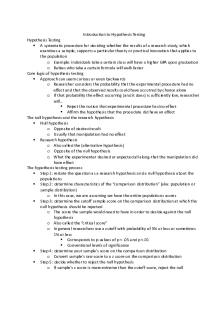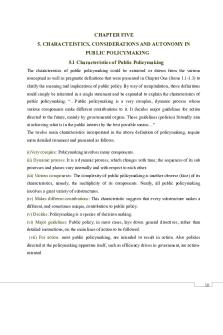Metabolism includes - Lecture notes Chapter one to five PDF

| Title | Metabolism includes - Lecture notes Chapter one to five |
|---|---|
| Author | Devin Chris |
| Course | Biology Concepts |
| Institution | Phoenix College |
| Pages | 4 |
| File Size | 39 KB |
| File Type | |
| Total Downloads | 26 |
| Total Views | 128 |
Summary
Chapter one to five...
Description
Metabolism includes the sum of the chemical reactions that occur within a cell. In a metabolic pathway, substrate Z is broken down to form products Y and X. Y is further broken down into products V and W. Two enzymes are needed: one to break down Z and one to break down Y. Glycolysis is found in most every type of cell, therefore, it must have evolved early in the history of life. Glycolysis is an anaerobic process as it requires no oxygen. While the citric acid cycle and acetyl CoA conversion take place during aerobic respiration, they do not directly rely on oxygen. Only the electron transport chain directly relies on oxygen as a terminal electron acceptor. The maximum number of ATP produced during aerobic respiration is 38. Other sugars as well as fats and proteins can be used as possible fuel for cellular respiration. The reason for cramps and sore muscles complaints was that there was a lactate build up in their muscles due to anaerobic exercise. Prokaryotic cells carry out cellular respiration but they do not contain mitochondria. The elements of the respiratory pathway are present in the plasma membrane. The outer mitochondrial membrane would come from the engulfing vesicle. Cristae refers to the folds of the inner mitochondrial membrane. This folded inner membrane would have represented the original prokaryotic membrane. Fermentation only produces 2 ATP while aerobic respiration produces 3436 ATP. Without phosphate, ADP cannot be converted back to ATP. So the cycle would stop when all the ATP had been converted to ADP. Cells are the basic unit of structure and function of all living things. Louis Pasteur proved that the spontaneous generation of life was not possible in 1864. The cell theory states that all living things are made of cells. Therefore, anything not made of cells is not living. Biologists classify cells into two broad categories—the prokaryotes and eukaryotes. Only the plasma membrane is present in both eukaryotic and prokaryotic cells.
Because bacteria are prokaryotes, they do not have a nucleus, but they do have DNA. The phospholipid bilayer that surrounds/maintains the integrity of a cell is called the plasma membrane. The cytoplasm is the semi-fluid internal medium found within the cell. An organelle is any well-defined subcellular structure, so the cytoplasm is not an organelle. However, the cytoplasm does contain organelles. The plasma membrane is a phospholipid bilayer, so it consists of two layers of phospholipids. It is believed that the ancient prokaryotic cells were members of domain Archaea. Groups of prokaryotic cells do live together in groups and share products of metabolism but this is not considered part of how the first eukaryotic cells came to be. In the fluid-mosaic model of the plasma membrane, the phospholipid molecules are oriented so that the hydrophilic heads are facing the outside environment and the hydrophobic tails are facing the interior of the membrane. The nucleus contains the genetic information. All of the rest are functions of the plasma membrane. The fluid-mosaic model is the current model of the membrane structure of a cell. A short chain of sugar attached to a protein is called a glycoprotein. Gases and non-polar molecules can cross the plasma membrane because of its selective permeability. Osmosis is the diffusion of water across a semi-permeable membrane. The salt water is a hypertonic solution which can cause the death of the marsh plants by drawing water out of their cells. Molecules of cholesterol add support to the plasma membrane. In order to maintain a state of equilibrium the same number of molecules need to enter the cell as the number of molecules that leave the cell. Normal saline is isotonic to red blood cells in your blood since the salt concentrations are equal. In isotonic solutions, the water is equal inside and outside the cell. In a hypertonic solution, there are more particles outside of the cell. In a hypotonic solution, there
are fewer particles outside of the cell. In hypertonic solutions, there is less water outside the cell. In a hypotonic solution, there is more water outside of the cell. Cells placed in pure water would swell until they burst Facilitated transport is the assisted transport of a molecule across the cell membrane without an expenditure of energy. Sodium is pumped out of the cell while potassium is pumped into the cell. Phagocytosis involves the engulfing of an object by a cell. During exocytosis, the vesicle membrane fuses with the plasma membrane, so the phospholipids of the vesicle will end up in the plasma membrane. The Golgi apparatus is a stack of slightly curved saccules that are important in packaging and secretion. The nucleolus is an obvious dark-stained, RNA-rich structure housed in the nucleus of eukaryotic cells. The grainy-looking substance inside the nucleus is chromatin, a combination of DNA molecules and proteins. Every cell in the body contains the same genes. If a cell lacked ribosomes it would not be able to engage in protein synthesis. Ribosomes are organelles composed of proteins and rRNA. Both the rough and smooth endoplasmic reticulum form transport vesicles. The primary role of the ribosome is to synthesize proteins within the cell. The Golgi apparatus is involved in processing, packaging, and secretion. Lysosomes contain hydrolytic enzymes and are particularly numerous in phagocytic white blood cells. Microbodies are not a part of the cytoskeleton. Actin filaments are used in movement of the cell and are very thin fibers. Intermediate filaments are not the thinnest fibers. Microtubules are very large filaments. Centrosomes are the microtubule organizing center of the cell. Cilia are associated with cellular movement but are not thin filaments. They are composed of bundles of microtubules. Centrosomes are responsible for the regulation of microtubule assembly. The cytoskeleton is not responsible for the processing of proteins. Sperm contain flagella that enable them to move. Human eggs do not move on their own, they are pushed along the female reproductive tract by cilia in the tract. The lining of the respiratory tract and uterine tubes contain cilia that help move particles along. The urinary system does not contain flagella or cilia.
Microtubules form spindle fibers during mitosis and meiosis, which assist the movement of chromosomes. The lack of cilia on the cells that line the respiratory tract would result in recurrent respiratory infections. Tight junctions are necessary to contain fluids within a specific area....
Similar Free PDFs

Chapter One Lecture Notes
- 5 Pages

Protein Metabolism - Lecture notes 7
- 11 Pages

Lecture ONE Notes
- 16 Pages

Chapter Five - ACCO 440 NOTES
- 11 Pages
Popular Institutions
- Tinajero National High School - Annex
- Politeknik Caltex Riau
- Yokohama City University
- SGT University
- University of Al-Qadisiyah
- Divine Word College of Vigan
- Techniek College Rotterdam
- Universidade de Santiago
- Universiti Teknologi MARA Cawangan Johor Kampus Pasir Gudang
- Poltekkes Kemenkes Yogyakarta
- Baguio City National High School
- Colegio san marcos
- preparatoria uno
- Centro de Bachillerato Tecnológico Industrial y de Servicios No. 107
- Dalian Maritime University
- Quang Trung Secondary School
- Colegio Tecnológico en Informática
- Corporación Regional de Educación Superior
- Grupo CEDVA
- Dar Al Uloom University
- Centro de Estudios Preuniversitarios de la Universidad Nacional de Ingeniería
- 上智大学
- Aakash International School, Nuna Majara
- San Felipe Neri Catholic School
- Kang Chiao International School - New Taipei City
- Misamis Occidental National High School
- Institución Educativa Escuela Normal Juan Ladrilleros
- Kolehiyo ng Pantukan
- Batanes State College
- Instituto Continental
- Sekolah Menengah Kejuruan Kesehatan Kaltara (Tarakan)
- Colegio de La Inmaculada Concepcion - Cebu











